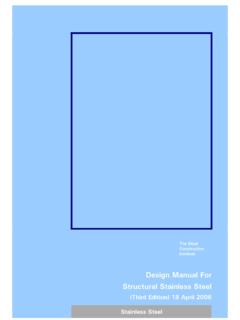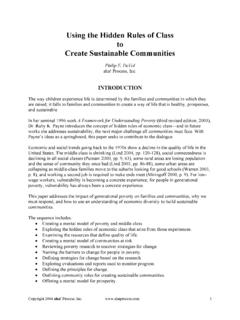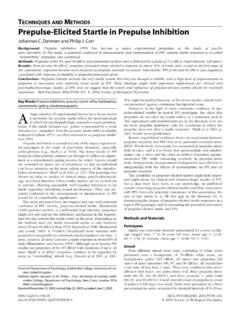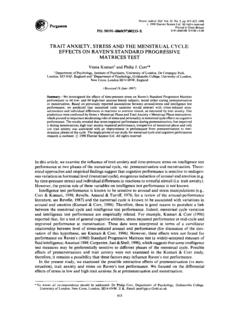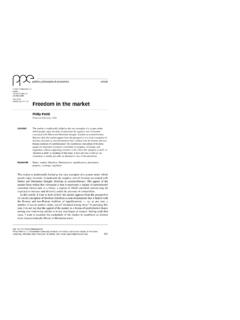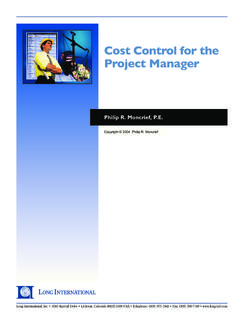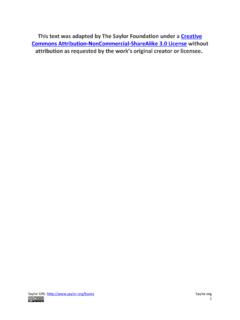Transcription of Nancy Baddoo and Philip Francis The Steel Construction ...
1 Paper Presented by Nancy Baddoo - Nancy Baddoo and Philip Francis , SCI 1 Development of design rules in the AISC Design Guide for Structural Stainless Steel Nancy Baddoo and Philip Francis The Steel Construction Institute, Silwood Park, Ascot, SL5 7QN, UK Abstract This paper describes the development of an AISC (American Institute of Steel Construction ) Design Guide for hot rolled and welded structural stainless Steel sections. Where stainless Steel behaves in a similar way to carbon Steel , the Design Guide simply refers to the relevant section in ANSI/AISC 360-10 Specification for Structural Steel Buildings. Where the guidance in the AISC Specification would be unconservative when applied to stainless Steel , specific rules for stainless Steel were derived and presented in a format as close as possible to the equivalent expressions in AISC 360.
2 The stainless Steel design rules were calibrated against an extensive database of test results on members and connections. A full reliability analysis was carried out to calculate the LRFD resistance factors; in most cases, the carbon Steel resistance factors were shown to be applicable to stainless Steel also. Keywords Stainless Steel , design specification, AISC, reliability, resistance factors, structural members 1 Background Stainless steels are increasingly used in Construction because they are highly corrosion resistant and attractive, while having good strength, toughness and fatigue properties in combination with low maintenance requirements. They are used in aggressive environments, for example applications near salt water, exposed to deicing salts or in very heavily polluted locations.
3 Industrial structures like platforms, barriers, gates and equipment supports for the food and beverage, water treatment, pulp and paper, nuclear, biomass, chemical and pharmaceutical industries are often made from stainless steels. They are also used for pedestrian and vehicular bridge components exposed to aggressive environments. Stainless Steel structural components are a popular choice for supporting glass curtain walls, as well as for roofs, canopies, seismic components, security barriers and other applications that need good corrosion resistance and strength to reduce maintenance requirements and improve safety. They are widely used for hand railing and street furniture for the same reasons. Figures 1 to 8 show examples of recent structural applications of stainless Steel .
4 Fig. 1 Schubert Club Band Shell, St. Paul, Minnesota Photo: Skidmore, Owings & Merrill LLP Fig. 2 Stainless Steel frame in nuclear power plant Photo: Stainless Structurals LLC The yielding and work-hardening characteristics of stainless steels mean that conventional carbon Steel design rules based on observing the limit of elastic deformation do not apply; the elastic 'limit' of stainless steels is not sharply defined as they work-harden rather than yield with the onset of plastic deformation. Since early structural applications in the 1920 s like the reinforcement chain around the dome of St Paul s Cathedral in London, structural engineers have been addressing the challenge of developing appropriate rules in design codes which enable the maximum advantage to be taken of stainless Steel properties.
5 Paper Presented by Nancy Baddoo - Nancy Baddoo and Philip Francis , SCI 2 Fig. 3 Stainless Steel staircase in brewery Photo: Stainless Structurals LLC Fig. 4 Stainless Steel sign support, Tampa Photo: TriPyramid Structures, Inc. Fig. 5 Stainless Steel I-shaped beams at Thames Gateway Water Treatment Works Photo: Interserve Fig. 6 Stainless Steel columns in The Pavilion, Regents Place, London Photo: Arup Fig. 7 Harbor Drive Pedestrian Bridge, San Diego, US Photo: Brooke Duthie photography & Lin International Fig. 8 Stainless Steel railway bridge, A orga, Spain Photo: Outokumpu 2 Introduction to AISC Design Guide: Structural Stainless Steel Although an SEI/ASCE Specification for the Design of Cold-Formed Stainless Steel Structural Members has been available for many years [1], there is no US design specification covering hot rolled and welded stainless Steel .
6 This has been a major obstacle to the wider use of stainless Steel structures, forcing designers and owners to conduct their own investigations or abandon stainless Steel in favour of alternative materials which have readily available design guidance and specification rules. Designers determined to use stainless Steel have either been required to work from first principles, or use carbon Steel rules, sometimes applying an arbitrary additional safety factor. This is unsatisfactory; Paper Presented by Nancy Baddoo - Nancy Baddoo and Philip Francis , SCI 3 working from first principles is wasteful of the designer s time and application of carbon Steel rules with an extra safety factor is unlikely to lead to economic design with a consistent level of reliability.
7 In 2009, work started on the development of an AISC Design Guide for structural stainless Steel , supported by the US stainless Steel industry and associated market development associations [2]. The motivation behind the project was that the availability of design guidance for structural stainless Steel aligned to US codes would facilitate greater and more efficient use of hot rolled and welded products in the Americas and other parts of the world, which use US AISC design specifications with little or no modification. The AISC Design Guide was written so that designers who are familiar with ANSI/AISC 360-10 Specification for Structural Steel Buildings [3] would be able to use it without any difficulty. Where stainless Steel behaves in a similar way to carbon Steel , the Design Guide simply refers to the relevant section in AISC 360.
8 Where the guidance in the AISC Specification would be unconservative or unduly conservative when applied to stainless Steel , specific rules for stainless Steel have been presented in a format as close as possible to the equivalent expressions in the AISC 360 for carbon Steel . The AISC Design Guide is intended for the design of primary and secondary structural components. It covers aspects of material properties, grade selection and durability. Design rules for members and connections (bolted and welded) are given at ambient temperatures and in fire. Guidance on fatigue, fabrication and erection are given also. For special structures such as those in nuclear installations or pressure vessels, additional requirements may need to be considered, which are outside the scope of the Design Guide.
9 The guidance relates to common hot rolled and welded sections (I-sections, Channels, T-sections, round, square and rectangular Hollow Structural Sections (HSS) and angles) with thickness in. (3 mm) and greater. In accordance with AISC 360, the Design Guide gives guidance in two formats: LRFD (Load and Resistance Factor Design) philosophy and ASD (Allowable Stress Design). The Design Guide specifically covers the popular austenitic grades 304/304L and 316/316L and the standard and lean duplex grades. Guidance is also included on the use of certain precipitation hardening grades for tension members, fixings and fasteners (these stainless steels are useful when very high strengths are needed).
10 The Design Guide refers to AISC, ASTM and other US and internationally relevant standards and reference documents for information outside the scope of the Design Guide. Not surprisingly, the scope of the design rules is more limited than the scope of AISC 360; they cover commonly encountered structural shapes and load scenarios, but not every scenario in AISC 360. At the end of the Design Guide, six design examples are given which illustrate the application of the design rules. Stainless Steel s non-linear stress-strain relationship means that certain carbon Steel design rules require modification, for example some local buckling limits, member buckling curves and methods for estimating deflection of beams. As well as nonlinearity, the stress-strain characteristics of stainless steels also display non-symmetry of tensile and compressive behaviour and anisotropy (differences in behaviour of coupons aligned parallel and transverse to the rolling direction).




